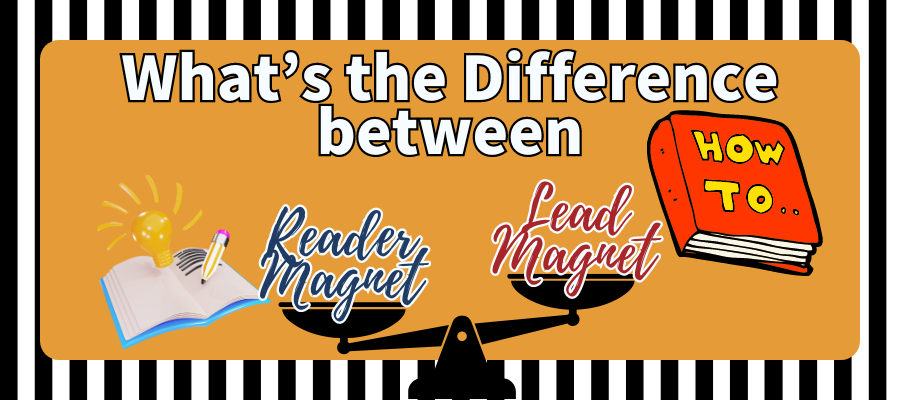
In the world of digital marketing and content creation, the terms “lead magnet” and “reader magnet” are often used interchangeably, leading to confusion among many entrepreneurs and authors alike.
However, understanding the key differences between these two powerful tools is crucial for crafting an effective content strategy that actually attracts, engages, and converts your followers and causal readers into loyal advocates of your brand and your books.
Let’s define each term’s distinct purposes, how they’re used, and why they’re essential components of any successful marketing strategy.
What is a Reader Magnet?
First things first – what exactly is a reader magnet?
A reader magnet is a like a gift you offer to your readers in exchange for their email addresses. It could be a short story, a prequel to your latest novel, or even a collection of bonus content – anything that entices those readers to join your email list and become a part of your literary community.
What is a Lead Magnet?
A lead magnet is a valuable piece of content offered by an online business or marketer to potential customers in exchange for their email address.
It serves as an incentive to encourage individuals to engage with a brand, website, or social media posts and take a specific action. This action would allow them to have access to a webinar or live event, able to download an ebook, or access to exclusive content available only to those who chose to subscribe.
What are More Terms for Lead Magnet?
Before we explain the difference between a reader magnet and a lead magnet, knowing the many words, or terms for a reader magnet can help to understand those terms.
The main difference between these terms is the industry in which they’re used, and the goal behind the what you’re trying to do.
Here’s a list of these terms
- reader magnet
- lead magnet
- printable
- downloadable asset
- opt-in incentive
- ethical bribe / bribe
- VIP content
- subscriber bonus
- reader upgrade
- content offer
- content opt-in
- exclusive offer
- irresistible offer
- gift
- sign-up incentive
- free download
- content upgrade
- bonus content

What’s the Difference Between a Reader Magnet and a Lead Magnet?
Still confused over the different terms used for a reader magnet. Please note, the term “lead magnet” is actually the leading marketing term, the most general term used.
But the difference comes down to intent. What’s the goal of your marketing?
While both reader magnets and lead magnets are designed to attract and capture leads, their ultimate goals are slightly different.
A reader magnet is specifically tailored to attract readers – hence the name – and is usually a piece of content that appeals directly to your ideal reader’s interests and preferences. It’s a specific type of content targeted towards the romance readers who read your book. Typically, it offers a taste of your writing style, the world in your story, or the characters that star in your book.
On the other hand, a lead magnet can be more generalized and may target a broader audience beyond just readers. It’s a general marketing term for any freebie offered in exchange for their email address. It’s a designed to attract a broad audience interested in a particular niche or solve a problem.
While, yes, there can be an overlap in thought, as in a free novella in a fantasy series can function as both a lead magnet (attracting new fantasy readers) and a reader magnet (hooking those readers to your book series), these terms are often used interchangeably in marketing campaigns.
What is the Purpose of a Reader Magnet aka Lead Magnet?
The primary goal of a lead magnet is to attract, engage, and capture leads in exchange for valuable content. This allows you to grow your email lists, continue to nurture your readers, and even drive more sales.
However, the specific term used in place of “lead magnet” can differentiate the goal of the content and the desired action you want from your audience.
For example, a “reader magnet” may specifically target the readers following you on social media where you aim to entice them to join your email list by offering a free ebook or the promise of exclusive content.
On the other hand, terms like “opt-in incentive,” “freebie,” or “ethical bribe” are more general and encompass a broader range of content offerings designed to incentivize your followers to take a specific action, such as subscribing to a newsletter, attending a live event, or downloading a helpful resource.
Ultimately, while the overarching goal of these content offerings may be lead generation, the specific terms used can help to clarify the intended audience and the action you want them to take, thus shaping your content strategy and messaging to align with your overall message.
Conclusion
While both reader magnets and lead magnets serve the purpose of attracting and engaging potential readers, they do so in different ways and with different goals in mind.
By understanding the nuances between these two powerful terms, you can craft more targeted and effective strategies to grow your readership, build your email list, and ultimately achieve greater success in your endeavors.
So whether you’re enticing readers with a sneak peek of your latest novel, or offering a valuable resource to attract more readers, harnessing the power of readers magnets aka lead magnets can take your marketing to new heights.

Want to join a group making content together?? Click here.
Looking to have your content made for you? Contact me anytime via email.
Dive deep into the Ultimate Guide to Mastering your Online Content to know how to update and optimize your content.
You can Master Your Content with content kits available.